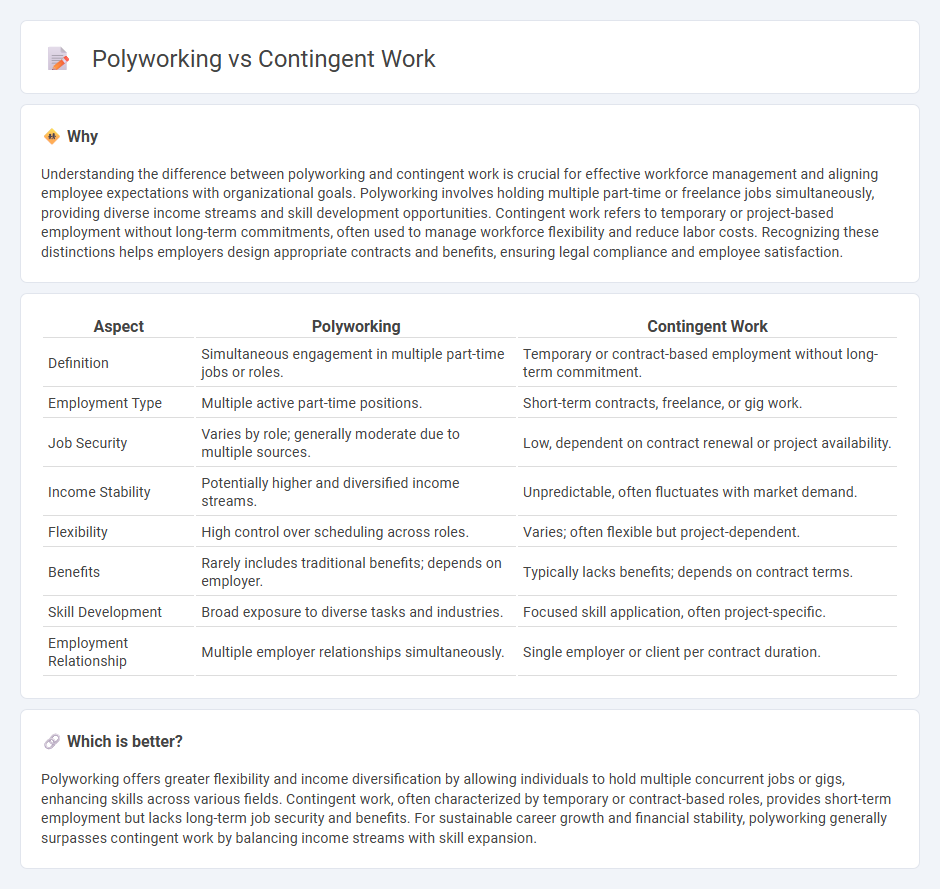
Polyworking involves juggling multiple jobs or roles simultaneously, offering greater income diversity and skill development. Contingent work refers to non-permanent, flexible employment arrangements such as freelancing, temporary contracts, or gig work, often lacking traditional benefits. Explore the evolving trends and implications of polyworking versus contingent work in today's labor market.
Why it is important
Understanding the difference between polyworking and contingent work is crucial for effective workforce management and aligning employee expectations with organizational goals. Polyworking involves holding multiple part-time or freelance jobs simultaneously, providing diverse income streams and skill development opportunities. Contingent work refers to temporary or project-based employment without long-term commitments, often used to manage workforce flexibility and reduce labor costs. Recognizing these distinctions helps employers design appropriate contracts and benefits, ensuring legal compliance and employee satisfaction.
Comparison Table
| Aspect | Polyworking | Contingent Work |
|---|---|---|
| Definition | Simultaneous engagement in multiple part-time jobs or roles. | Temporary or contract-based employment without long-term commitment. |
| Employment Type | Multiple active part-time positions. | Short-term contracts, freelance, or gig work. |
| Job Security | Varies by role; generally moderate due to multiple sources. | Low, dependent on contract renewal or project availability. |
| Income Stability | Potentially higher and diversified income streams. | Unpredictable, often fluctuates with market demand. |
| Flexibility | High control over scheduling across roles. | Varies; often flexible but project-dependent. |
| Benefits | Rarely includes traditional benefits; depends on employer. | Typically lacks benefits; depends on contract terms. |
| Skill Development | Broad exposure to diverse tasks and industries. | Focused skill application, often project-specific. |
| Employment Relationship | Multiple employer relationships simultaneously. | Single employer or client per contract duration. |
Which is better?
Polyworking offers greater flexibility and income diversification by allowing individuals to hold multiple concurrent jobs or gigs, enhancing skills across various fields. Contingent work, often characterized by temporary or contract-based roles, provides short-term employment but lacks long-term job security and benefits. For sustainable career growth and financial stability, polyworking generally surpasses contingent work by balancing income streams with skill expansion.
Connection
Polyworking involves individuals simultaneously holding multiple part-time or freelance jobs, often within the contingent work sector characterized by temporary, flexible contracts without long-term commitments. Both polyworking and contingent work reflect shifts toward a gig economy where employment stability decreases but task variety and autonomy increase. Businesses leverage contingent workers to manage fluctuating labor demands, while polyworkers maximize income streams and diversify skill sets across short-term roles.
Key Terms
Flexibility
Contingent work offers temporary or project-based employment with flexibility in scheduling, often lacking job security and benefits, while polyworking involves juggling multiple jobs or roles simultaneously to optimize income and skill diversity. Flexibility in contingent work centers on choosing when and how much to work for a single employer, whereas polyworking requires balancing different commitments across various fields. Explore the distinct advantages and challenges of each to determine the best fit for your career goals.
Multiple Employers
Contingent work involves temporary or contract-based employment often tied to a single employer, whereas polyworking refers to simultaneously holding multiple jobs across different employers to diversify income streams. Polyworkers balance various roles, leveraging flexibility and skill sets to maximize career opportunities and financial resilience. Explore more about how polyworking compares to traditional contingent work models.
Job Security
Contingent work typically offers less job security due to temporary contracts and fluctuating project availability, whereas polyworking, involving multiple concurrent roles, can diversify income sources and reduce dependency on a single employer. Job security in contingent roles is often minimal, with limited benefits and unpredictable income, while polyworking allows individuals to manage risks by balancing various positions and industries. Explore how these work models impact financial stability and career growth to make informed decisions.
Source and External Links
Contingent work - Wikipedia - Contingent work is a non-permanent employment relationship with limited job security, often part-time or variable hours, including roles like freelancers, contractors, and temporary workers, widely used across industries in the US workforce.
What Is a Contingent Workforce? - Oracle - A contingent workforce consists of contractors, freelancers, and temporary workers hired on a contractual basis for specific projects or defined time, offering flexibility to both workers and organizations to fill skills gaps or temporary needs.
Contingent Worker vs. Contract Employee: What's the Difference? - Contingent workers are hired temporarily for projects or peak workloads and enjoy flexibility and autonomy over their work, contrasting with contract employees who usually have a fixed contract timeline and more direct oversight.
 dowidth.com
dowidth.com